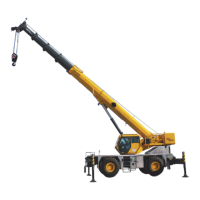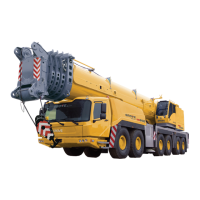Grove Published 3-23-2020, Control # 654-04 4-7
GRT655/655L OPERATOR MANUAL OPERATING PROCEDURES
5. Make sure emergency stop switch is not pressed.
6. Make sure parking brake is set to On position the
transmission shift lever is positioned to Neutral.
NOTE: Engine will not crank unless transmission shift
lever is in neutral.
NOTE: An engine block heater and grid heater are
provided to aid in cold-starting.
7. Turn ignition switch clockwise to position I (RUN).
The Engine Warning Indicator (23, Figure 4-18 and
Figure 4-19) and the Engine Stop Indicator (22,
Figure 4-18 and Figure 4-19) will come on and go off in
sequence after approximately two seconds (as a check).
If the Engine Wait-to-Start Indicator (14, Figure 4-18 and
Figure 4-19) is on, do not crank engine until the indicator
goes off.
If the Engine Warning Indicator or the Engine Stop
Indicator remains on, correct the malfunction before
cranking the engine.
8. Sound the horn by pressing the button on the right
controller or by pressing the button on the end of the turn
signal lever on the steering column.
9. Turn the ignition switch clockwise to position II (START)
and release immediately when the engine starts.
Do not push or hold the throttle pedal down. The ECM
automatically provides the proper amount of fuel to start
the engine.
10. Warm up engine and all crane components following the
procedures under Crane Warm-up Procedures,
page 4-11.
Idling Engine
Idling the engine unnecessarily for long periods of time
wastes fuel and fouls injector nozzles. Unburned fuel causes
carbon formation; oil dilution; formation of lacquer or gummy
deposits on valves, pistons and rings; and rapid
accumulation of sludge in the engine. These conditions
become worse in colder climates.
NOTE: When prolonged engine idling is necessary,
maintain at least 800 rpm.
Engine High Idle
Idling the engine for long periods of time results in the
degradation of engine oil and damage to engine
components, as described under Idling Engine, page 4-7.
To reduce these adverse effects, the Crane Control System
(CCS) will automatically increase the engine idle speed to
approximately 1200 rpm when the following conditions are
met for a period of 5 minutes:
• Transmission is in neutral
• Parking brake is engaged
• Brake pedal is not pressed
• Engine speed is less than 1125 rpm
• Controllers are not actuated
• Engine coolant temperature is below 71°C (160°F)
• Manual exhaust system cleaning process has not been
initiated
• Automatic exhaust system cleaning process is not active
The crane control system will automatically return the engine
idle speed to its usual setting when one of the following
conditions occur:
• Transmission is shifted to forward or reverse
• Parking brake is disengaged
• Brake pedal is pressed
• Controller is actuated
• Engine coolant temperature rises above 79°C (175°F)
• Exhaust System Cleaning Switch is set to the Manual
Cleaning position
• Exhaust system cleaning process is active
Racing Engine
DO NOT race engine during warm-up period or operate
beyond governed speed (as might occur in downhill
operation or down-shifting). Engine bearings, pistons, and
valves may be damaged if these precautions are not taken.
Exhaust System Cleaning
When to Manually Clean the Exhaust System
The Diesel Particulate Filter (DPF) Clogged Indicator (30,
Figure 4-18 and Figure 4-19) is located in the Operator
Display Module (ODM). This indicator comes on (amber)
when the exhaust system requires cleaning.
When the DPF Clogged indicator comes on or flashes, start
the manual cleaning process at the next opportune time.
CAUTION
If the Engine Warning Indicator or the Engine Stop
Indicator is on, immediately stop the engine and correct
the malfunction.

